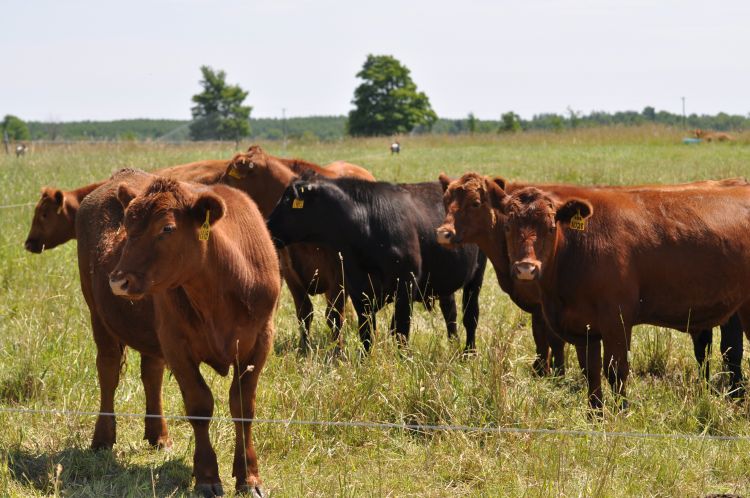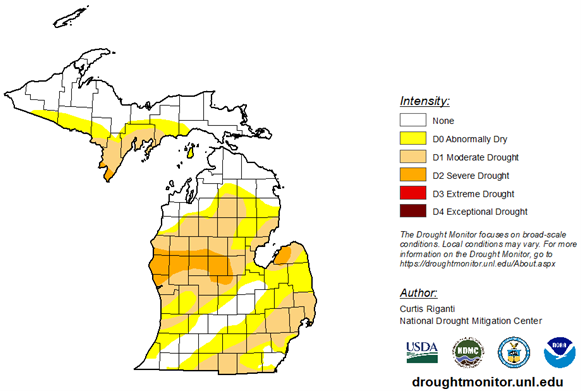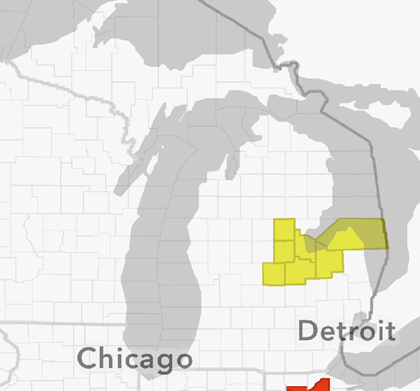Seven Michigan counties qualify for Livestock Forage Disaster payments
The Livestock Forage Disaster Program provides compensation to eligible livestock producers who have dealt with loss of forage due to drought.

Persistent drought conditions within Michigan in 2025 have left livestock producers and their grazing lands at risk for forage loss. As shown in Figure 1, many Michigan counties are currently experiencing some level of drought conditions. The USDA Farm Service Agency (FSA) administers the Livestock Forage Disaster Program (commonly referred to as LFP). LFP provides compensation to eligible livestock producers who have dealt with loss of forage due to drought.

Which producers are eligible for LFP?
To be eligible for LFP, producers must own, cash or share lease, or be a contract grower of eligible livestock during the 60 calendar days before the beginning date of a qualifying drought. Eligible livestock are grazing animals that get the majority of their nutrition via grazing of forage grasses or legumes. These can include alpacas, beef cattle, buffalo/bison, beefalo, dairy cattle, deer, elk, emus, equine, goats, llamas, ostrich, reindeer or sheep. Producers must provide pasture or grazing land for covered livestock. This includes cash-rented land as of the date of the qualifying drought. Such land must be physically located in a county affected by a qualifying drought during the normal grazing period for the county.
What is considered a qualifying drought?
Qualifying droughts are determined by the U.S. Drought Monitor, using existing measures: D2 (severe drought), D3 (extreme drought), and D4 (exceptional drought). LFP compensation amounts are based on the severity and duration of drought conditions.
If any part of the county experiences severe drought conditions (D2) for at least eight consecutive weeks during the normal grazing period, producers are eligible for one monthly payment. If any area of a county reaches D3 at any period of time during the normal grazing period, producers are eligible for compensation equal to three monthly payments. Table 1 summarizes the remaining payment rates and drought qualifications.
Table 1. LFP Payment Rates for Eligible Drought Counties
|
Drought Level |
Conditions* |
Payment Equal To |
|
D2 (Severe) |
8 consecutive weeks |
One monthly payment |
|
D3 (Extreme) |
Any period of time |
Three monthly payments |
|
4 weeks |
Four monthly payments |
|
|
D4 (Exceptional) |
Any period of time |
Four monthly payments |
|
4 weeks |
Five monthly payments |
|
|
*In any area of the county during the normal grazing period |
||
What are the payment terms?
The LFP monthly payment rate for drought is calculated as 60% of the monthly feed cost for the lesser of either all covered livestock owned or leased by a producer or the number of livestock comprising the normal carrying capacity of the producer’s eligible grazing land. For example, the base beef cow payment rate for 2025 would be 60% of $41.40, resulting in $24.84 per head. The maximum annual payment per producer is set at $125,000 per year. Table 2 shows the feed costs used to calculate LFP monthly payment rates in 2025.
Table 2. Monthly Feed Costs by Eligible Livestock Type for 2025
|
Livestock |
Type |
Weight Range |
Monthly Feed Cost |
|
Beef |
Adult |
Bulls, Cows |
$41.40 |
|
Non-Adult |
500 pounds or more Less than 500 pounds |
$31.05 $20.70 |
|
|
Dairy |
Adult |
Bulls, Cows |
$107.64 |
|
Non-Adult |
500 pounds or more Less than 500 pounds |
$31.05 $20.70 |
|
|
Beefalo |
Adult |
Bulls, Cows |
$41.40 |
|
Non-Adult |
500 pounds or more Less than 500 pounds |
$31.05 $20.70 |
|
|
Buffalo/Bison |
Adult |
Bulls, Cows |
$41.40 |
|
Non-Adult |
500 pounds or more Less than 500 pounds |
$31.05 $20.70 |
|
|
Sheep |
All |
|
$10.35 |
|
Goats |
All |
|
$10.35 |
|
Deer |
All |
|
$10.35 |
|
Equine |
All |
|
$30.64 |
|
Elk |
All |
|
$22.36 |
|
Reindeer |
All |
|
$9.11 |
|
Alpacas |
All |
|
$9.11 |
|
Emus |
All |
|
$21.19 |
|
Llamas |
All |
|
$15.11 |
|
Ostrich |
All |
|
$22.77 |
What counties qualify for LFP payments in Michigan?
In previous years, very few Michigan counties have met eligibility requirements for this program. In both 2023 and 2024, only one county experienced severe drought for eight consecutive weeks (Gogebic in 2023, Lenawee in 2024), and no counties experienced extreme or exceptional drought conditions during the normal grazing period. This year, however, seven Michigan counties have met the D2 level drought requirements (at some point during the 2025 grazing season). These counties, highlighted in Figure 2, include Bay, Gladwin, Gratiot, Huron, Midland, Saginaw, and Tuscola. Eligible producers in these counties qualify for payments on land that is native pasture, full-season improved pasture, or forage sorghum.

How do I apply for LFP payments?
To apply for LFP payments for the 2025 grazing period, eligible producers must provide a completed application (form CCC-853) to their USDA FSA office by March 1, 2026. More information can be found at USDA FSA offices. To find your local USDA FSA office, use the link provided here: USDA Service Centers.



 Print
Print Email
Email




